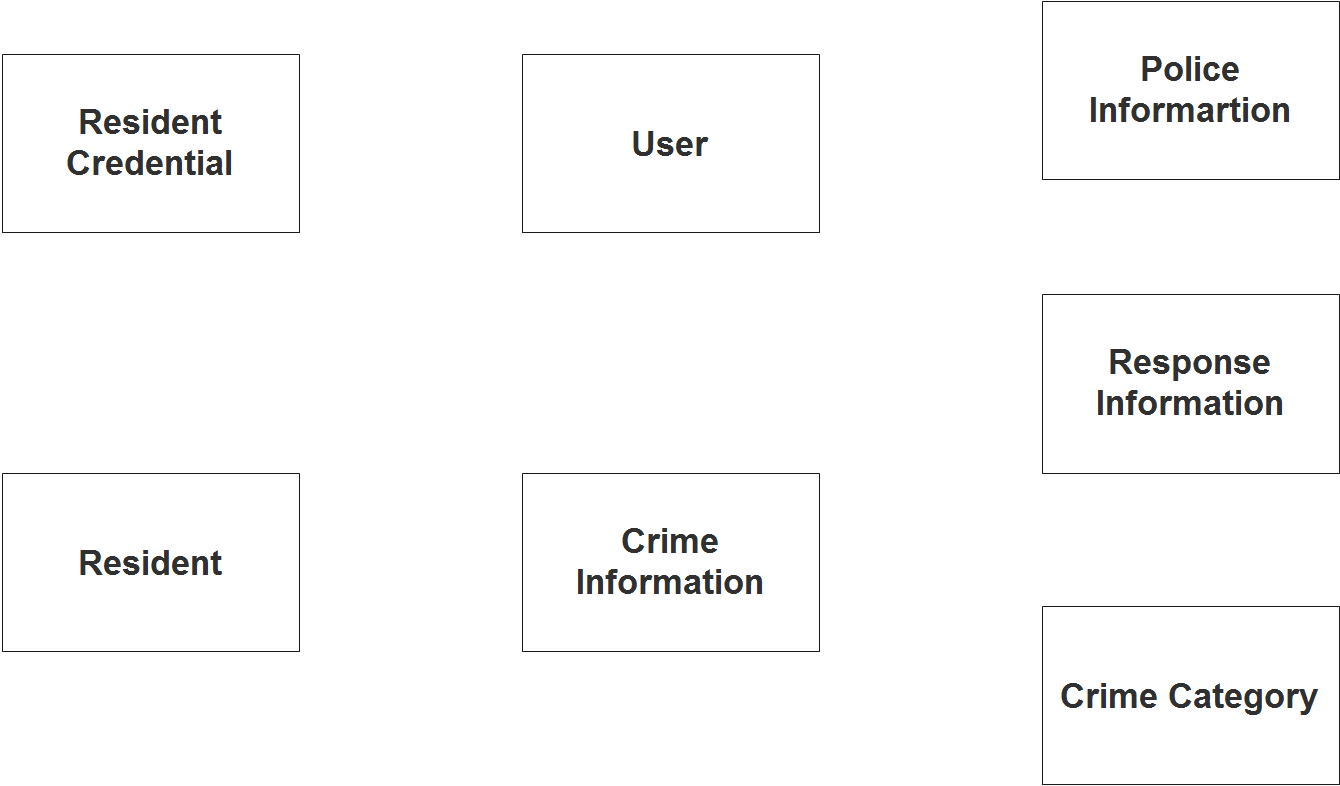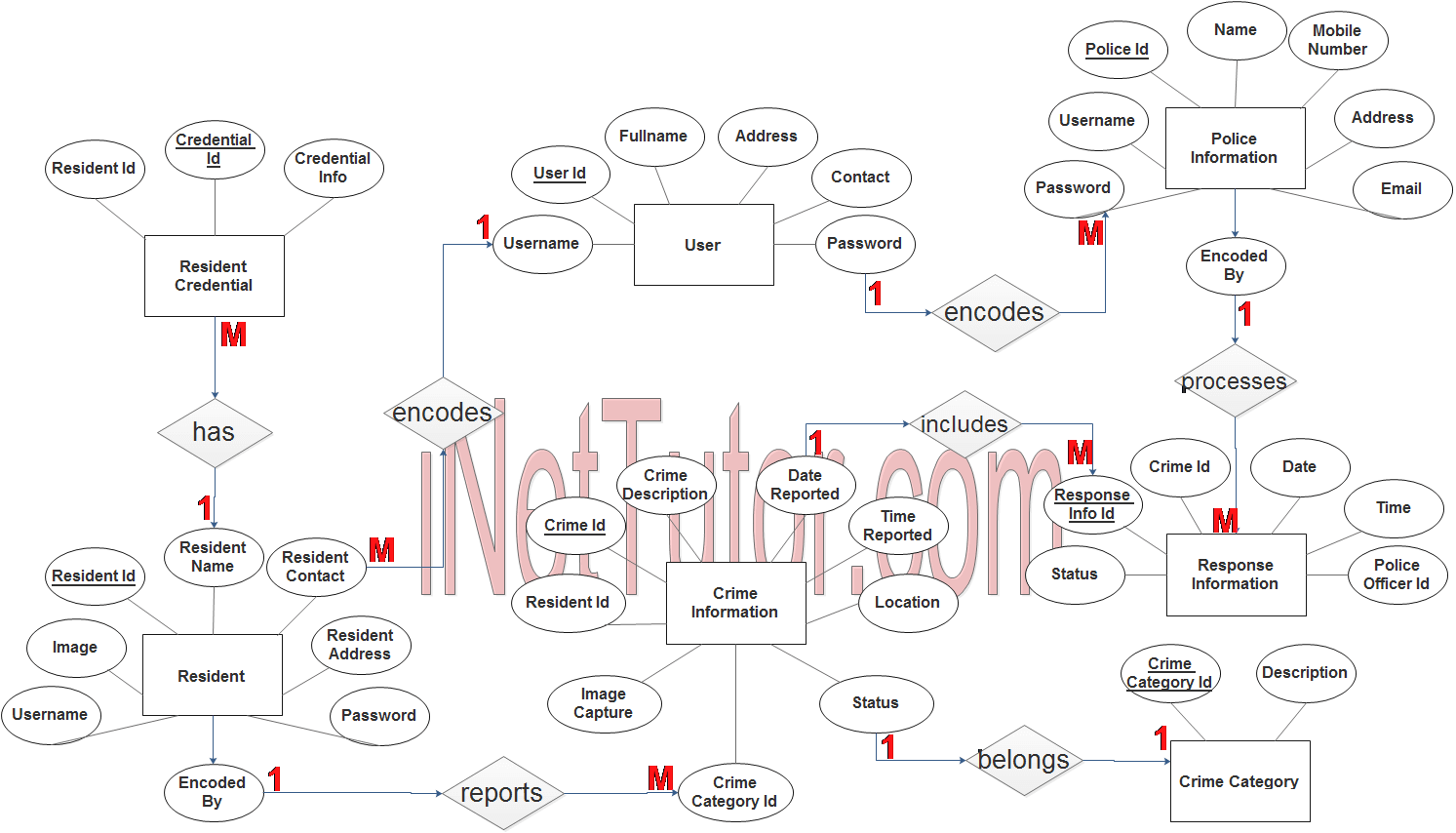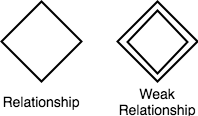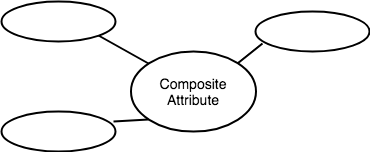Er Diagram For Online Fir System
Crime Reporting System ER Diagram
This article will discuss the step by step process on how to prepare the entity relationship diagram or ERD of the project entitled Crime Reporting System.
The objective of the project entitled Crime Reporting System is to provide an avenue for the residents and police to report and respond to crimes reported through this platform. The project was designed and developed in PHP, MySQL and Bootstrap. For more information about the project, you may visit the database design and screen layout of crime reporting system, just search for crime reporting database design and crime reporting user interface.
The first step in the development of the Crime Reporting System is to prepare the ER diagram that will serve as the basis later on in the creation of the actual database.
We will create and explain the process of making the entity relationship diagram of crime reporting system.
Let's start from the symbols used in the ER Diagram.
Entity is represented by the rectangle shape. The entity will be our database table of Crime Reporting System later on.
Attribute is represented by the oval shape. This will be the columns or fields of each table in the Crime Reporting System.
Relationship is represented by diamond shape. This will determine the relationships among entities. This is usually in a form of primary key to foreign key connection.
We will follow the 3 basic rules in creating the ER Diagram.
- Identify all the entities.
- Identify the relationship between entities and
- Add meaningful attributes to our entities.
Step 1. In the Crime Reporting System we have the following entities
- User
- Resident
- Resident Credential
- Crime Information
- Crime Category
- Police Information
- Response Information
We will now draw the entities of the Crime Reporting System specified above and it will be represented by a rectangle shape.

Step 2. After we have specified our entities, it is time now to connect or establish a relationship among the entities.

- User encodes information of residents (1 to many relationship).
- A resident uploads or submits their resident credentials (1 to many relationship).
- A resident reports a crime through the online and mobile application of the project (1 to many relationship).
- User encodes information of police officer (1 to many relationship).
- The police officer responds to the crimes reported by the residents (1 to many relationship).
- The crime belongs to a specific crime category (1 to 1 relationship).
Step 3. The last part of the ERD process is to add attributes to our entities.

User Entity has the following attributes:
- User ID – primary key represented with underline
- Full name
- Address
- Contact
- Username
- Password
Resident Entity has the following attributes:
- Resident ID – primary key represented with underline
- Resident Name
- Resident contact
- Resident address
- Image
- Username
- Password
- Encoded By – foreign key
Resident Credential Entity has the following attributes:
- Credential ID – primary key represented with underline
- Resident ID – foreign key
- Credential Info
Crime Information Entity has the following attributes:
- Crime ID – primary key represented with underline
- Crime Description
- Resident ID – foreign key
- Date Reported
- Time Reported
- Location
- Image Capture
- Status
Crime Category Entity has the following attributes:
- Crime Category ID – primary key represented with underline
- Description
Police Information Entity has the following attributes:
- Police ID – primary key represented with underline
- Name
- Mobile Number
- Address
- Username
- Password
- Encoded by – foreign key
Response Information Entity has the following attributes:
- Response Info ID – primary key represented with underline
- Crime ID – foreign key
- Status
- Date
- Time
- Police Officer ID – foreign key
Note: all attributes with underline represents the primary key of the entity or table.
The next step is to convert the plan designed on ER Diagram into the actual database, please search for the Crime Reporting System article which was already posted.
Contact us on our facebook page for the softcopy of the Crime Reporting System.
You may visit our facebook page for more information, inquiries and comments.
Hire our team to do the project.
Source: https://www.inettutor.com/diagrams/crime-reporting-system-er-diagram/
Posted by: antioineae219839folwka.blogspot.com
Sample Er Diagram For Student Database
Working with ER Diagrams
ER Diagram is a visual representation of data that describes how data is related to each other. In ER Model, we disintegrate data into entities, attributes and setup relationships between entities, all this can be represented visually using the ER diagram.
For example, in the below diagram, anyone can see and understand what the diagram wants to convey: Developer develops a website, whereas a Visitor visits a website.

Components of ER Diagram
Entitiy, Attributes, Relationships etc form the components of ER Diagram and there are defined symbols and shapes to represent each one of them.
Let's see how we can represent these in our ER Diagram.
Entity
Simple rectangular box represents an Entity.

Relationships between Entities - Weak and Strong
Rhombus is used to setup relationships between two or more entities.

Attributes for any Entity
Ellipse is used to represent attributes of any entity. It is connected to the entity.

Weak Entity
A weak Entity is represented using double rectangular boxes. It is generally connected to another entity.

Key Attribute for any Entity
To represent a Key attribute, the attribute name inside the Ellipse is underlined.

Derived Attribute for any Entity
Derived attributes are those which are derived based on other attributes, for example, age can be derived from date of birth.
To represent a derived attribute, another dotted ellipse is created inside the main ellipse.

Multivalued Attribute for any Entity
Double Ellipse, one inside another, represents the attribute which can have multiple values.

Composite Attribute for any Entity
A composite attribute is the attribute, which also has attributes.

ER Diagram: Entity
An Entity can be any object, place, person or class. In ER Diagram, an entity is represented using rectangles. Consider an example of an Organisation- Employee, Manager, Department, Product and many more can be taken as entities in an Organisation.

The yellow rhombus in between represents a relationship.
ER Diagram: Weak Entity
Weak entity is an entity that depends on another entity. Weak entity doesn't have anay key attribute of its own. Double rectangle is used to represent a weak entity.

ER Diagram: Attribute
An Attribute describes a property or characterstic of an entity. For example, Name, Age, Address etc can be attributes of a Student. An attribute is represented using eclipse.

ER Diagram: Key Attribute
Key attribute represents the main characterstic of an Entity. It is used to represent a Primary key. Ellipse with the text underlined, represents Key Attribute.

ER Diagram: Composite Attribute
An attribute can also have their own attributes. These attributes are known as Composite attributes.

ER Diagram: Relationship
A Relationship describes relation between entities. Relationship is represented using diamonds or rhombus.

There are three types of relationship that exist between Entities.
- Binary Relationship
- Recursive Relationship
- Ternary Relationship
ER Diagram: Binary Relationship
Binary Relationship means relation between two Entities. This is further divided into three types.
One to One Relationship
This type of relationship is rarely seen in real world.

The above example describes that one student can enroll only for one course and a course will also have only one Student. This is not what you will usually see in real-world relationships.
One to Many Relationship
The below example showcases this relationship, which means that 1 student can opt for many courses, but a course can only have 1 student. Sounds weird! This is how it is.

Many to One Relationship
It reflects business rule that many entities can be associated with just one entity. For example, Student enrolls for only one Course but a Course can have many Students.

Many to Many Relationship

The above diagram represents that one student can enroll for more than one courses. And a course can have more than 1 student enrolled in it.
ER Diagram: Recursive Relationship
When an Entity is related with itself it is known as Recursive Relationship.

ER Diagram: Ternary Relationship
Relationship of degree three is called Ternary relationship.
A Ternary relationship involves three entities. In such relationships we always consider two entites together and then look upon the third.

For example, in the diagram above, we have three related entities, Company, Product and Sector. To understand the relationship better or to define rules around the model, we should relate two entities and then derive the third one.
A Company produces many Products/ each product is produced by exactly one company.
A Company operates in only one Sector / each sector has many companies operating in it.
Considering the above two rules or relationships, we see that although the complete relationship involves three entities, but we are looking at two entities at a time.
Source: https://www.studytonight.com/dbms/er-diagram.php
Posted by: antioineae219839folwka.blogspot.com
Rules For Constructing Buildings In Dnd 5e
We are well into the second month in the great blank-slate world of Nowhere, and Domain Game players are busy taming—or being tamed by—this brave new world. While cyclopean ruins, mysterious golden barges, vast metal domes, white-furred apes, and other oddities have beguiled the expeditions from Elsewhere, they are making a go at the more prosaic job of settling into their new dominions.
Everywhere is the sound of hammers, saws, and the rest of the general din of construction. Ziggurats, longhouses, towers, stockades, mud huts are slowly and surely being raised in this howling wilderness.
And as goes the flurry activity so go the gnomes behind the scenes working to ensure the smooth flow of the natural laws of the new world—that is the in-game mechanics for the larger rules supplement project.
For the rest of you we give you this today: construction rules for your classical D&D game. For the full version including road construction, underground excavation, and all the lovely modifiers that give you that fine crunch you can find it here as part of the revised rules guidelines (including some other rules for would-be overlords).
Construction
To build a structure:
-
the type of structure(s) to be built
-
The number of ten-foot square cubes to be built of that structure
-
Number of workers assigned
-
Where the materials are to come from etc.
 Example: Margrave von Schadenfreude wants to have 50 followers start working on five small one-story wooden cottages that are 10 feet by 30 feet (3 cubes).
Example: Margrave von Schadenfreude wants to have 50 followers start working on five small one-story wooden cottages that are 10 feet by 30 feet (3 cubes).
Since the Margrave's project is in a wilderness area, he will direct another group of his followers to harvest the needed materials directly. Thatch from the grasslands will be used and timber cut from the adjacent light woods.
Total labor time for the project is 480 worker/days (15 cubes x 32, the base-rate for an average wooden structure). Since he has 50 workers on the project it will take them 9.6 days (480 divided by 50) to complete building the cottages–barring any delays.
Baseline Cost and Time
All work based on 10'x10' "cubes". All prices applicable if structure is in a borderlands or civilized hex. Substitute gp equivalent amount of materials for wilderness area.
Any building over two cubes must have at least one semi-skilled worker for eight cubes. Any building over 24 cubes, must have an engineer or architect assigned for every 48 cubes.
| Material | Price per Cube | Construction Time |
| Primitive | 10 gp | 25 worker/days |
| Mudbrick | 20 gp | 30 worker/days |
| Wooden | 30 gp | 32 worker/days |
| Brick | 110 gp | 90 worker/days |
| Stone | 140 gp | 160 worker/days |
Quality level
Building is assumed to come with basic furnishings, roofing, and flooring appropriate to the quality level. Additional or unusual furnishings must be purchased separately.
| Cheap | 75% price/time |
| Average | 100% price/time |
| Comfortable | 150% price/time |
| Semi-Fortified | 200% price/time |
| Luxurious | 250% price/time |
| Fortified | 300% price/time |
Vertical building
Second-story building is free. Add 25% to the cost for each additional story.
Misc. Structures
| Amount | Cost | Construction Time | |
| Wood fence | 10' length, 6" wide | 20 gp | 5 worker/days |
| Wooden palisade | 10' length, 2' wide | 80 gp | 25 worker/days |
| Ditch | 10' length, 10' wide | 60 gp | 20 worker/days |
| Abatis | 10' length, 3' wide | 40 gp | 10 worker/days |
| Earthworks | 10' length, 5' wide | 60 gp | 15 worker/days |
| Stone curtain wall | 10' length, 5' thick | 250 gp | 100 worker/days |
| Reinforced door | 1 panel | 40 | 2 worker/days |
| Portcullis | 1 panel | 600 | 15 worker/days |
| Secret door | 1 panel | 400 | 20 worker/days |
Source: http://hillcantons.blogspot.com/2011/02/construction-rules-for-classic-d.html
Posted by: antioineae219839folwka.blogspot.com
1987 Vw Cabriolet Belt Diagram
How Did the VW Beetle Become an Emblem of the '60s?

Two festival goers that found Woodstock too much lay passed out on the bonnet and roof of their Volkswagen Beetle. Credit: Three Lions/Getty Images
These days, we think of the Volkswagen Beetle as an emblem of 1967's Summer of Love. The well-known counterculture social phenomenon put San Francisco's Haight-Ashbury neighborhood on the map — and it helped the Beetle solidify its place as a hippie symbol. But there's more to the "love bug" than its late '60s success story. In fact, the VW Beetle benefited greatly from one of the most successful rebranding efforts in modern history.
The Origins of Volkswagen: World War II
While the VW Beetle is now synonymous with free love and the 1960s, the vehicle's darker origins began a good three decades prior. In 1933, white supremacist and German dictator Adolf Hitler announced what he called a "people's motorization," and, the following year, the Reich Association of the German Automobile Industry officially challenged the country's automotive industry to develop a "volks wagen," or people's car.

The body of the Beetle is mounted on the chassis at the Volkswagen Factory in Wolfsburg in 1962. Credit: Erich Andres/United Images/Getty Images
But this alleged "car of the people" effort was something of a propaganda-minded guise. That is, Ferdinand Porsche developed the vehicle under the motto "strength through pleasure," and aimed to make an all-terrain vehicle for Nazi military use. In fact, the car's brochure stated that it was "suitable not only for personal use but also for transport and particular military purposes." By May of 1938, Volkswagen's Wolfsburg-based factory opened and began churning out vehicles.
After Nazi forces were defeated in 1945, Germany's automotive production factories were put under the control of the British government. More than 10,000 Beetles were manufactured by the end of 1946, and, by the end of the decade, Volkswagen had sold around one million Beetles. In fact, it was also during this time that the now-iconic Volkswagen model was dubbed the "Beetle."
Undoubtedly, distancing the Beetle from its unsettling, dark roots was a large undertaking, but, within less than two decades, the vehicle would be reclaimed. And transformed into a counterculture symbol for anti-war, anti-government folks who celebrated free love.
Beetle-Mania: Marketing Was Key to the VW Beetle's Success
In 1972, the Wolfsburg manufacturing plant hit a notable milestone: It had manufactured 15,007,034 Beetles, thus surpassing the amount of Ford Model T cars. So, how did this rebranded vehicle's popularity surge? The VW Beetle was affordable — and compact.

Photo Courtesy: Wikimedia Commons
First off, it's air-cooled engine, for example, was much smaller and lighter than a water-cooled system. This notable feature also made it much easier to maintain and repair the car. Not only was the Beetle less of an investment upfront, but it didn't cost owners a ton overtime. Additionally, The Beetle's size was a key factor in its popularity in the United States.
Crafted by the New York-based ad agency Doyle Dane Bernbach, what's been dubbed "one of the greatest advertising campaigns of all time" helped make the Beetle the "biggest selling foreign-made car in America throughout the '60s" (via BBC). This 1959 "Think Small" campaign was a departure from traditional automotive advertising, which was full of bluster, fantasy and illustrations of the vehicle. Instead, "Think Small" featured simple, clean photographs of the Beetle, presenting it as a practical, compact alternative to the muscle cars and gas-guzzlers on the market.
"The message was one of smart anti-luxury," a car blog points out. "[And it] took gentle aim at an industry obsessed with superficiality and styling, rather than the substance underneath the car bodies." In many ways, it's a lot like Apple's initial marketing stance and aesthetic: Keep it minimal and emphasize those everyday needs.
That clever marketing angle, combined with a low price and quirky appearance, helped cement the Beetle as an early symbol of '60s counterculture. (Well, alongside its cousin, the VW van.) "For the Woodstock generation, driving a Beetle or its larger cousin, the Volkswagen van, was a form of protest against materialism and the gas guzzlers churned out by the big American carmakers," The New York Times notes.
The VW Beetle's Popularity Continues Post-1960s
Beetles were produced in Germany until 1978, after which production shifted to factories in Brazil and Mexico. In fact, the last Volkswagen Beetle was produced in Mexico in July 2003. By that point, approximately 30,000 Beetles were produced weekly, a figure that stands in stark contrast to the 1,300,000 Beetles produced every seven days in 1971.

Photo Courtesy: Erich Andres/United Images/Getty Images
In 1997, Volkswagen introduced the "New Beetle," which, among other changes, featured the engine in the front rather than the rear. The New Beetle was produced until 2003, before becoming the A5 Volkswagen Beetle, which was sold until 2019. (A scandal involving Volkswagen's attempted violation of the Clean Air Act certainly didn't help, especially in the age of green-minded, electric vehicles.)
In total, a staggering 23 million Beetle models were sold over an 83-year period. So, will this pop culture icon be back any time soon? In December 2020, the CEO of Volkswagen, Scott Keogh, was asked just that. "You know, with the Beetle, never say never," Keogh said. "We're certainly gonna keep its, you know, soul alive."
Source: https://www.reference.com/history/how-vw-beetle-became-emblem-60s?utm_content=params%3Ao%3D740005%26ad%3DdirN%26qo%3DserpIndex
Posted by: antioineae219839folwka.blogspot.com
2014 Vw Beetle Convertible Fuse Diagram
How Did the VW Beetle Become an Emblem of the '60s?

Two festival goers that found Woodstock too much lay passed out on the bonnet and roof of their Volkswagen Beetle. Credit: Three Lions/Getty Images
These days, we think of the Volkswagen Beetle as an emblem of 1967's Summer of Love. The well-known counterculture social phenomenon put San Francisco's Haight-Ashbury neighborhood on the map — and it helped the Beetle solidify its place as a hippie symbol. But there's more to the "love bug" than its late '60s success story. In fact, the VW Beetle benefited greatly from one of the most successful rebranding efforts in modern history.
The Origins of Volkswagen: World War II
While the VW Beetle is now synonymous with free love and the 1960s, the vehicle's darker origins began a good three decades prior. In 1933, white supremacist and German dictator Adolf Hitler announced what he called a "people's motorization," and, the following year, the Reich Association of the German Automobile Industry officially challenged the country's automotive industry to develop a "volks wagen," or people's car.

The body of the Beetle is mounted on the chassis at the Volkswagen Factory in Wolfsburg in 1962. Credit: Erich Andres/United Images/Getty Images
But this alleged "car of the people" effort was something of a propaganda-minded guise. That is, Ferdinand Porsche developed the vehicle under the motto "strength through pleasure," and aimed to make an all-terrain vehicle for Nazi military use. In fact, the car's brochure stated that it was "suitable not only for personal use but also for transport and particular military purposes." By May of 1938, Volkswagen's Wolfsburg-based factory opened and began churning out vehicles.
After Nazi forces were defeated in 1945, Germany's automotive production factories were put under the control of the British government. More than 10,000 Beetles were manufactured by the end of 1946, and, by the end of the decade, Volkswagen had sold around one million Beetles. In fact, it was also during this time that the now-iconic Volkswagen model was dubbed the "Beetle."
Undoubtedly, distancing the Beetle from its unsettling, dark roots was a large undertaking, but, within less than two decades, the vehicle would be reclaimed. And transformed into a counterculture symbol for anti-war, anti-government folks who celebrated free love.
Beetle-Mania: Marketing Was Key to the VW Beetle's Success
In 1972, the Wolfsburg manufacturing plant hit a notable milestone: It had manufactured 15,007,034 Beetles, thus surpassing the amount of Ford Model T cars. So, how did this rebranded vehicle's popularity surge? The VW Beetle was affordable — and compact.

Photo Courtesy: Wikimedia Commons
First off, it's air-cooled engine, for example, was much smaller and lighter than a water-cooled system. This notable feature also made it much easier to maintain and repair the car. Not only was the Beetle less of an investment upfront, but it didn't cost owners a ton overtime. Additionally, The Beetle's size was a key factor in its popularity in the United States.
Crafted by the New York-based ad agency Doyle Dane Bernbach, what's been dubbed "one of the greatest advertising campaigns of all time" helped make the Beetle the "biggest selling foreign-made car in America throughout the '60s" (via BBC). This 1959 "Think Small" campaign was a departure from traditional automotive advertising, which was full of bluster, fantasy and illustrations of the vehicle. Instead, "Think Small" featured simple, clean photographs of the Beetle, presenting it as a practical, compact alternative to the muscle cars and gas-guzzlers on the market.
"The message was one of smart anti-luxury," a car blog points out. "[And it] took gentle aim at an industry obsessed with superficiality and styling, rather than the substance underneath the car bodies." In many ways, it's a lot like Apple's initial marketing stance and aesthetic: Keep it minimal and emphasize those everyday needs.
That clever marketing angle, combined with a low price and quirky appearance, helped cement the Beetle as an early symbol of '60s counterculture. (Well, alongside its cousin, the VW van.) "For the Woodstock generation, driving a Beetle or its larger cousin, the Volkswagen van, was a form of protest against materialism and the gas guzzlers churned out by the big American carmakers," The New York Times notes.
The VW Beetle's Popularity Continues Post-1960s
Beetles were produced in Germany until 1978, after which production shifted to factories in Brazil and Mexico. In fact, the last Volkswagen Beetle was produced in Mexico in July 2003. By that point, approximately 30,000 Beetles were produced weekly, a figure that stands in stark contrast to the 1,300,000 Beetles produced every seven days in 1971.

Photo Courtesy: Erich Andres/United Images/Getty Images
In 1997, Volkswagen introduced the "New Beetle," which, among other changes, featured the engine in the front rather than the rear. The New Beetle was produced until 2003, before becoming the A5 Volkswagen Beetle, which was sold until 2019. (A scandal involving Volkswagen's attempted violation of the Clean Air Act certainly didn't help, especially in the age of green-minded, electric vehicles.)
In total, a staggering 23 million Beetle models were sold over an 83-year period. So, will this pop culture icon be back any time soon? In December 2020, the CEO of Volkswagen, Scott Keogh, was asked just that. "You know, with the Beetle, never say never," Keogh said. "We're certainly gonna keep its, you know, soul alive."
Source: https://www.reference.com/history/how-vw-beetle-became-emblem-60s?utm_content=params%3Ao%3D740005%26ad%3DdirN%26qo%3DserpIndex
Posted by: antioineae219839folwka.blogspot.com
